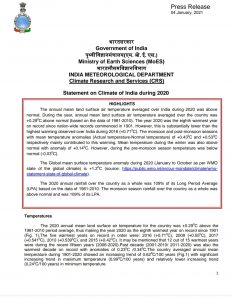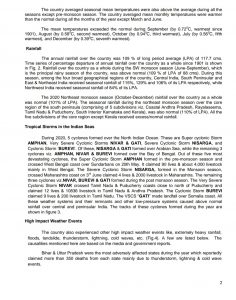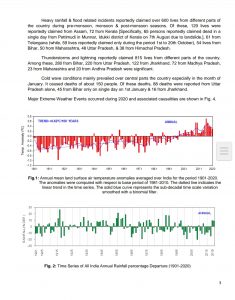New Delhi: The Climate Research and Services (CRS)of the India Meteorological Department (IMD) has issued a Statement on Climate of India during 2020.
The statement stated, “The annual mean land surface air temperature averaged over India during 2020 was above normal. During the year, the annual mean land surface air temperature averaged over the country was +0.290C above normal (based on the data of 1981-2010). The year 2020 was the eighth warmest year on record since nation-wide records commenced in 1901. However, this is substantially lower than the highest warming observed over India during 2016 (+0.710C).”
“The monsoon and post-monsoon seasons with mean temperature anomalies (Actual temperature-Normal temperature) of +0.430C and +0.530C respectively mainly contributed to this warming. The mean temperature during the winter was also above normal and the anomaly of +0.140C. However, during the pre-monsoon season temperature was below normal (-0.030C),” it read.

The Global mean surface temperature anomaly during 2020 (January to October as per WMO state of the global climate) is +1.20C (source: https://public.wmo.int/en/our-mandate/climate/wmo-statement-state-of-global-climate).
The 2020 annual rainfall over the country as a whole was 109 percent of its Long Period Average (LPA) based on the data of 1961-2010. The monsoon season rainfall over the country as a whole was above normal and was 109 percent of its LPA.
The annual rainfall over the country was 109 percent of the long period average (LPA) of 117.7 cms. Time series of percentage departure of annual rainfall over the country as a whole since 1901. Rainfall over the country as a whole during the SW monsoon season (June-September), which is the principal rainy season of the country, was above normal (109 percent of LPA of 88 cms).
During this season, among the four broad geographical regions of the country, Central India, South Peninsular, and East and Northeast India received seasonal rainfall of 115 percent, 129 percent, and 106 percent of its LPA respectively, while Northwest India received seasonal rainfall of 84 percent of its LPA.
The country also experienced other high-impact weather events like extremely heavy rainfall, floods, landslides, thunderstorms, lightning, cold waves, etc.
Bihar and Uttar Pradesh were the most adversely affected states during the year which reportedly claimed more than 350 deaths from each state mainly due to thunderstorms, lightning, and cold wave events.



